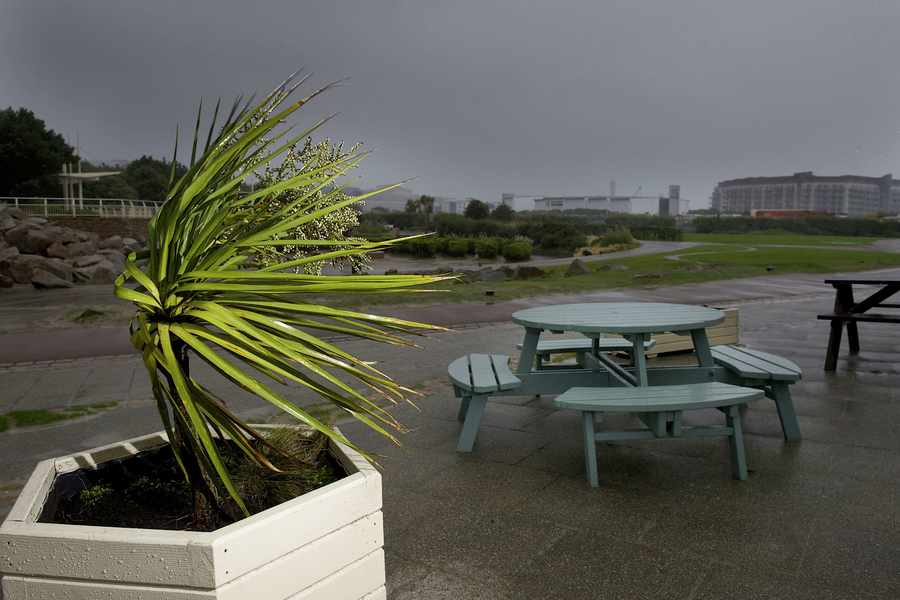Richard Heath reports:
IT all started so well. As June got going, so did the heat. During the first three weeks of the month – the first of a three-month period defined as summer by the Met Office – the mercury hovered around 20°C and occasionally shot up close to an almost Mediterranean 25°C.
The heat continued. And so did the sun. The classic and very-well rehearsed British summer routine of three days of heat and a ‘thundery breakdown’ just wasn’t happening. And by the end of the month – following more warmth and the hottest June day on record when the temperature hit 33°C – hundreds of NatWest Island Games athletes and spectators went home with a firm belief that Jersey was an Island of tropical summers.

Check the latest weather forecast here.[/breakout]
Then July came and it all went wrong.
Although the heat remained for the first week or so, the daily temperature chart on Jersey Met’s website shows a downward trend for most of the second half of the month. And any hopes that the arrival of August would bring a return to summer were quickly dashed, and we have already seen more than double the average rainfall for the month.
So why has summer become a washout? And what’s to blame?
The culprit, as always, is the jet stream. Each hemisphere has two jets, and the one affecting Britain is called the polar jet.
Lying about 39,000 ft above sea level, this narrow band of wind which forms a boundary between cold polar air to the north and the warmer air to the south is the Mr Big, the governor, the boss man of British weather.
Driving storms west to east across the Atlantic, it determines whether it is umbrella or sun cream, beach or cinema, barbecue or movie night. The jet, which can reach speeds of more than 200 mph, is usually positioned across central UK during the winter, helping to keep our winters wet but mild – often 10°C or more warmer than countries on a similar line of latitude. In the summer, it usually does the decent thing and migrates north, allowing high pressure to build in from the south to bring more settled and, depending on the wind direction, warm weather.
This year, however, the jet has become stuck in a more southerly position and it is showing no signs of moving.

‘This year, globally it is likely to be the hottest year on record. However, there are always going to be local variations and the British Isles have seen cooler conditions than normal,’ said John Searson, senior forecaster at the Jersey Met Office.
‘The problem we have had is that the jet stream has been running close to the islands. Normally in the summer it would be running relatively close to Scotland and therefore the wetter weather would be further north. This year it has been running further south very close to us, and so it has been driving low pressure systems very close to us.
‘The jet stream is in the upper atmosphere and it can often get stuck in a particular mode.
‘Unfortunately, in terms of predicting when the jet stream is going to break down, the science is not quite there yet.’

The statistics show just what an effect the jet stream has on our weather.
The Island enjoyed 315 hours of sunshine in June – way above the monthly average of 256.6 hours – when the jet was positioned further north. It was also drier than average with 41.4 mm of rain (compared to a monthly average of 48.2 mm) and the average daily maximum temperature was 0.6°C above average at 20.5°C – a figure pegged back slightly by a relatively cool start to the month.
July, which saw the jet sink further south, was wetter than average (65.7 mm of rain compared to an average of 44.3mm) and cloudier than average (247.6 hours of sunshine compared to 263.7 hours).
The temperature was almost the very definition of average (21.9°C compared to 21.8°C) – and that temperature only struggled up to average because night-time temperatures were kept reasonably mild by the frequent cloud cover.
This month has already seen 113 mm of rain – well above the monthly average of 51.3 mm – and little in the way of sunshine (164.8 hours so far, compared to a monthly average of 244.2 hours). On one night alone, 44 mm of rain fell on the Island, leaving a number of homes flooded.
And this week, as Jersey has been struck by a succession of storms, several trees across the Island have been blown down.
Little is known about why the jet gets fixed in a particular position for so long. But the bad news is that once it becomes stuck, it often sticks for a while. Much of the summer of 2012 was cold and wet after the jet stream got stuck unusually far south.
And when the jet plunged even further south in December 2010, it set up one of the coldest winters on record as mild Atlantic storms which usually batter us during the winter dived across southern Europe, leaving us to face weeks of cold but dry easterly winds.
Madeira, meanwhile, felt the full force of the storms and was left with extensive flooding.
As for the rest of the summer, it looks like the jury is still out. The UK Met Office is forecasting a ‘disturbed spell of weather’ for the rest of this week, with the chance of slightly more settled conditions for the start of next month.
But, by then, we will be in the three-month period defined by the Met Office as autumn – a season characterised by heavy rain and strong winds.

- The effects of the worlds jet streams were first documented after the eruption of Krakatoa in 1883, as scientists monitored the flow of ash across the worlds skies
- American pilot Wiley Post who in 1933 became the first man to fly solo around the world is often given some credit for the discovery of jet streams
- Pilots helped scientists learn more about the jet stream during the Second World War. The aviators often recorded tail winds of more than 100 mph when flying from the US to the UK
- The jet stream is the reason why flights from the US to the UK are often quicker than when going in the opposite direction. In January, a British Airways aircraft hopped onto a very fast-flowing jet stream and made it from New York in five hours and 16 minutes an hour and a half ahead of schedule[/breakout]






